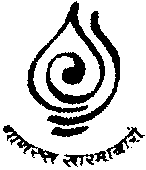
Vibrations Of The Karmic Body In The Gross Physical Body
That which we are seeing is the physical body. Within it there is the subtle body called tejas. That makes the physical body function and active. This is the source of vital energy. Scientists have developed such cameras as will photograph the aura. The definition in ancient times that that which breathes is living and that which does not is non-living is now outdated. When a man dies his nostril is blocked with cotton to check if he is living or dead. If the cotton moves then there is breath and the man is living. If it does not move it is assumed that he is dead. But this is outdated. The new definition of life is that whether there is breath or not, whether there is heartbeat or not, if the aura around a man breaks then he is dead.
Often it has happened that a few days after the heart stops beating man comes alive. Many people visit the crematorium and then return. Even if the heart stops and the breath is not there if his aura is still intact he will still get up from the pyre and walk back home. This aura is a reflection of the tejas. It holds the key to life. It is present both within and outside the physical bodies.
There is yet another subtle body inside the tejas body. That is the karmic body. The visible body is made of bio chemical molecules drawn from nutrition. The tejas body is in a bio-electrical field while the karmic body is made up of the minutest structures drawn from past impressions, samskaras and emotions. The karmic body is the strongest. It is the root cause for all other bodies. If it is there other bodies are there and if it is not there other bodies are not there. The physical body has direct contact with the tejas body. The tejas body is directly linked with the karmic body, which is in turn closely linked with the consciousness. The karmic body throws a curtain over the consciousness. That is why the consciousness is not able to know everything about the outside world. There are two points of the curtain which are a little loose. Peeping from that some rays of consciousness learning about the outside world. The karmic body imbibes some aspects of the outer world attracted by the physical body and also takes some of the influences of the consciousness to the outer world. There are four principal centres for this. Their names in order are:
- Gyan Kendra (Centre of knowledge)
- Satya Kendra (Centre of truth)
- Anand Kendra (Centre of bliss)
- Shakti Kendra (Centre of energy)
The four subsidiary centres are:
- Samvedan Kendra (Centre of sensations)
- Nirman Kendra (Centre of construction)
- Uplabdhi Kendra (Centre of gains)
- Jeevan Kendra (Centre of life)
The senses are centres of knowledge. They are located in the physical body. But the source of knowledge is not the physical body. The senses are in a sense centres for expression. There is a flow of knowledge from the karmic body into them. The karmic body with a continuous flow of knowledge feeds all the gyan Kendras in the body. As many doors as open in the karmic body, so many gyan centres are established in the gross body. Even the centres for bliss, energy and emotions are located in the karmic body. They are reflected in the gross body. The karmic body also experiences pain and pleasure. The event takes place in the gross body. The karmic body experiences the resultant sensations. When intoxicants are used the relation between the physical body and the karmic body breaks. In that state the body does not experience sensations of heat or cold or pain. Even illnesses arise from the karmic body and are expressed through the gross body. Desires (vasanas) arise in the karmic body and are expressed through the gross body. The relation between the gross body and the karmic body make the different states we are in. We look for both the problem and the solution in the physical body when it is actually to be found in the karmic body.
The karmic body is vibrating with our thoughts, emotions, resolutions and actions. During that time it is constantly accumulating new atoms while discarding the old ones (the process is called nirjara) When thoughts, emotions, resolution and activities are pure then the atoms are discarded at a faster rate and their pace of acquisition is slowed down. They affect the gyan centres of the gross body also. They develop better. When the process of acquiring new atoms is slowed down and gyan centres develop then the capacity for work of the consciousness increases. The capacity for work does not increase when only the gyan centres in the physical body develop. They increase only when the process of acquiring new atoms is slowed down. When we concentrate on any one gyan centre and meditate upon it then not only does the gyan centre in the gross body develop, even the gyan centre in the karmic body develops. The way to develop them is not only meditation. They develop with meditation, penance, contemplation and even when oneness with a soul free from attachment is established. In the Hatha yoga technique great emphasis has been placed on awakening the psychic centres (chakras) of the gross body.
The Jain tradition places more emphasis on reducing the karmic body and so more than Hatha yoga it is Raja yoga that is developed in it. Bhagvan Mahavira's sutra is to shake off the karmic body. The influence of Hatha yoga is greater on the vital energy. In Hatha yoga the vital energy is refined but purification of consciousness does not take place. That is to say that anger, ego, deceit and greed are not reduced. The seed of the karmic body lies in anger, ego, delusion and greed. The first and last point of Jain meditation technique is to be free from these four. The one who is free from them is called vitarag or detached. In him the vital energy cannot shine but his consciousness is pure and sacred. In him develops the knack of acquiring all knowledge about the world without using the medium of the senses. Knowledge becomes unobstructed, bliss undiluted and energy uncombated.
The tejas body (the vital energy or the pranic body) also develops with penance. But the main agenda of penance is to shake off the karmic body. Fasting, reducing food intake, resolutions with respect to diet, disregarding taste, kayaklesh and restraining the senses-these six methods of penance abandon the karmic body through the gross body. That is why Mahavira has called them external penance or bahirang yog.
Repentance (prayaschit), humility (vinay), service (vayyavrutya), self learning (svaadhyaya), meditation (dhyan), and renunciation (of passions and body) - these six types of penance influence the karmic body through the mind. That is why Mahavira has called it the antarang yog or internal penance. The vibrations of the karmic body expressed through the gross body are relatively stronger than those expressed through the mind. Their impact is internal and deeper. That is why there is a more intensive expression of molecules of the karmic body through the latter.
 Acharya Mahaprajna
Acharya Mahaprajna


